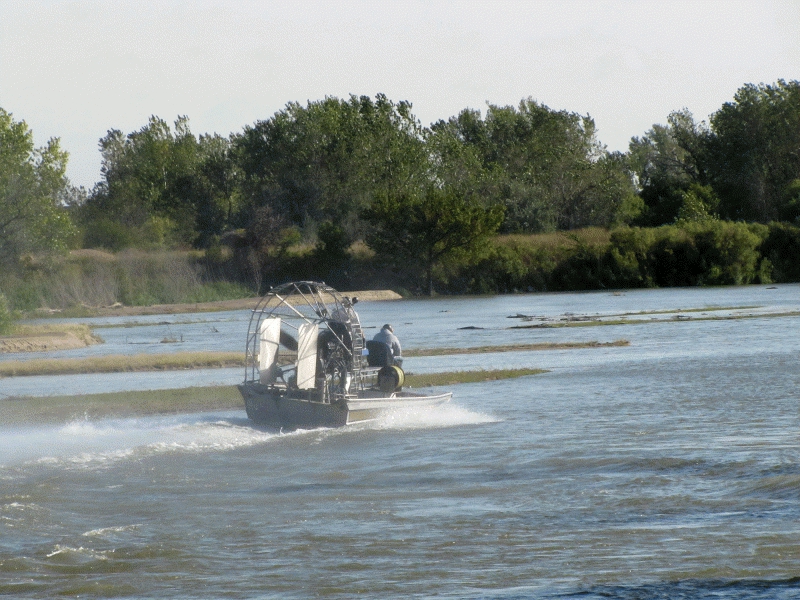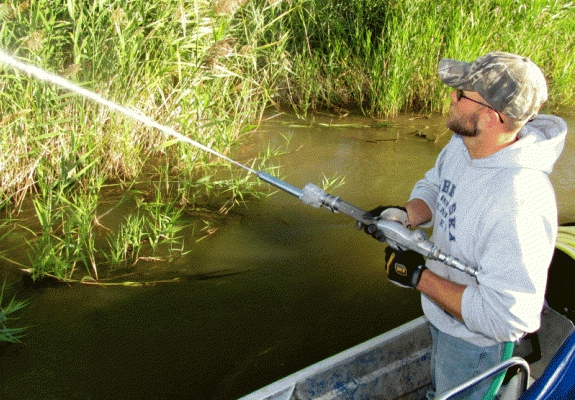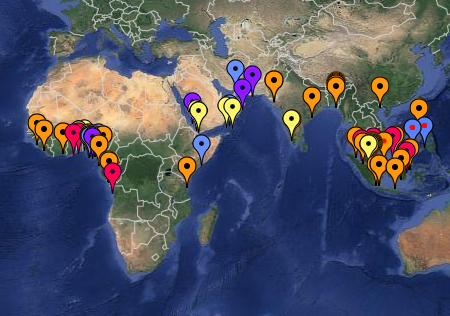airboat teams spray Platte River
By Lori Potter | Kearney Hub
Published Friday, September 24, 2010
KEARNEY — Hunting expeditions along the Platte River are nothing new for Jamion Aden of Cozad, but his prey this fall have roots, not fur, fins or feathers.
Aden and his work partner, Matt Linder, are patrolling riverbanks, sandbars and smaller channels by airboat from Odessa to three miles east of Gibbon looking for non-native invasive plants, specifically phragmites.
Their employer, Paulsen Inc. Habitat Services, is under contract with the Platte Valley Weed Management Area to do touch-up herbicide spraying of phragmites not killed by helicopter applications done a year ago. Other Paulsen teams are doing similar work west to North Platte.
Buffalo County Weed Superintendent and Platte Valley WMA Chairman Dick Kincaid said most of the river from Kingsley Dam in Keith County east to Columbus was aerial sprayed in 2009 under the oversight of the Platte Valley and West Central WMAs. However, weather didn’t allow spraying in two gaps, one in Keith County and a section between Gibbon and Wood River. Those areas were finished within the past three weeks, Kincaid said. Airboat patrols are catching smaller infestations of phragmites that couldn’t be sprayed by helicopters because of power lines, an overstory of trees or crops growing near the riverbank, he said.
“It’s the nooks and crannies where you don’t want (herbicide) drift or don’t have access,” Kincaid said. Aden and Linder use Platte River water to mix the aquatic-safe Habitat herbicide in tanks on the airboat. Spraying on riverbanks and small sandbars can be done from the boat. On larger sandbars, they use a long hose stored on a boat-mounted reel.
“We spray anything from the bank to 200 to 300 feet off the bank,” Aden said Wednesday morning, as long as weather conditions, particularly wind speed and direction, allow.
The team has worked between Gibbon and the Minden bridge for the past two weeks. They just started on the segment from Minden to Kearney, which is expected to take another two weeks.
Aden said the high water levels in the Platte are helping them. “We’re able to get down some channels we weren’t able to get to in the last year or two,” he said.
The water conditions aren’t favorable to mechanically removing phragmites sprayed last year and other channel-clogging vegetation such as willows. Platte Valley WMA Project Coordinator Rich Walters said the water is too high now to do that kind of work, which was planned for the main channel in western Buffalo and eastern Dawson counties upstream of Elm Creek. However, some contractors are making progress on side channels. Central Nebraska Public Power and Irrigation District officials plan to continue water releases from Lake McConaughy for optimum generation at downstream hydropower plants. That’s expected to result in higher river flows all winter.
“Mother Nature may take care of some of that (vegetation removal) with the high water flows,” Kincaid said. Meanwhile, he and Walters have patrolled the South Loup River in recent weeks scouting for phragmites, determining if what’s found is native or non-native, and spraying non-native phragmites and any purple loosestrife found in the channel or upland areas. Kincaid said an area from Boelus east to Custer County was covered last week. “We’re probably done in Buffalo County and now ready to go into Custer County,” he said.
Helicopters were used to survey the South Loup for invasive plants. “We’re seeing a lot more up close,” Kincaid said. When the South Loup is finished, he expects that similar inspections will be done in the Middle and North Loup basins.
View Kearney, NE, US in a larger map




